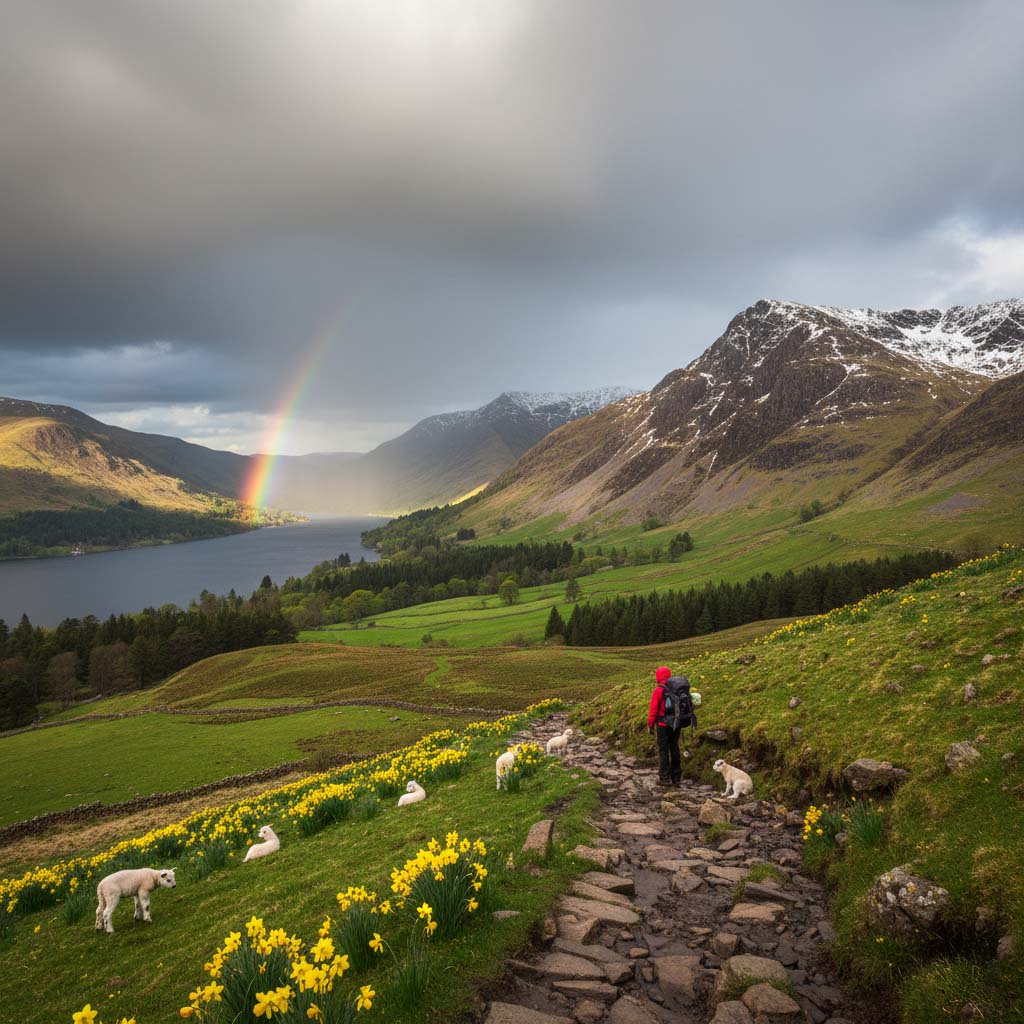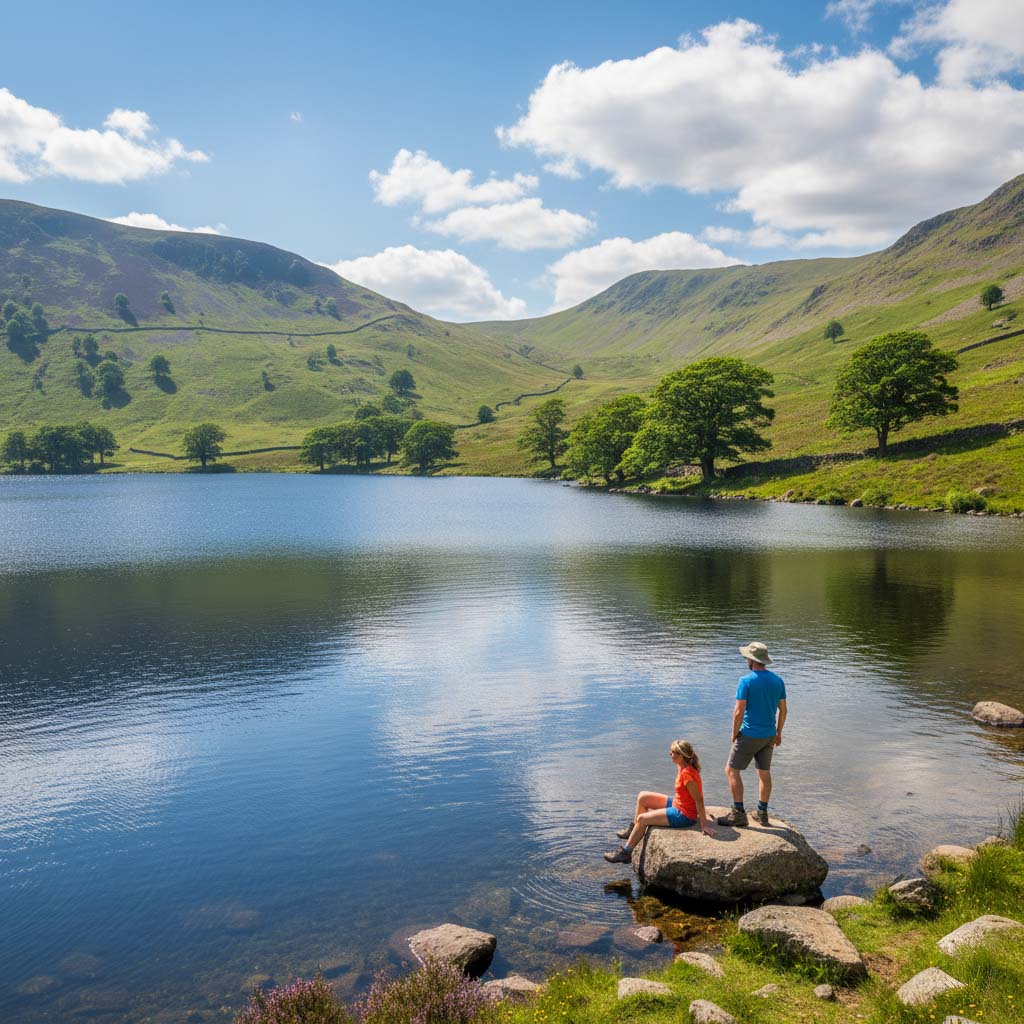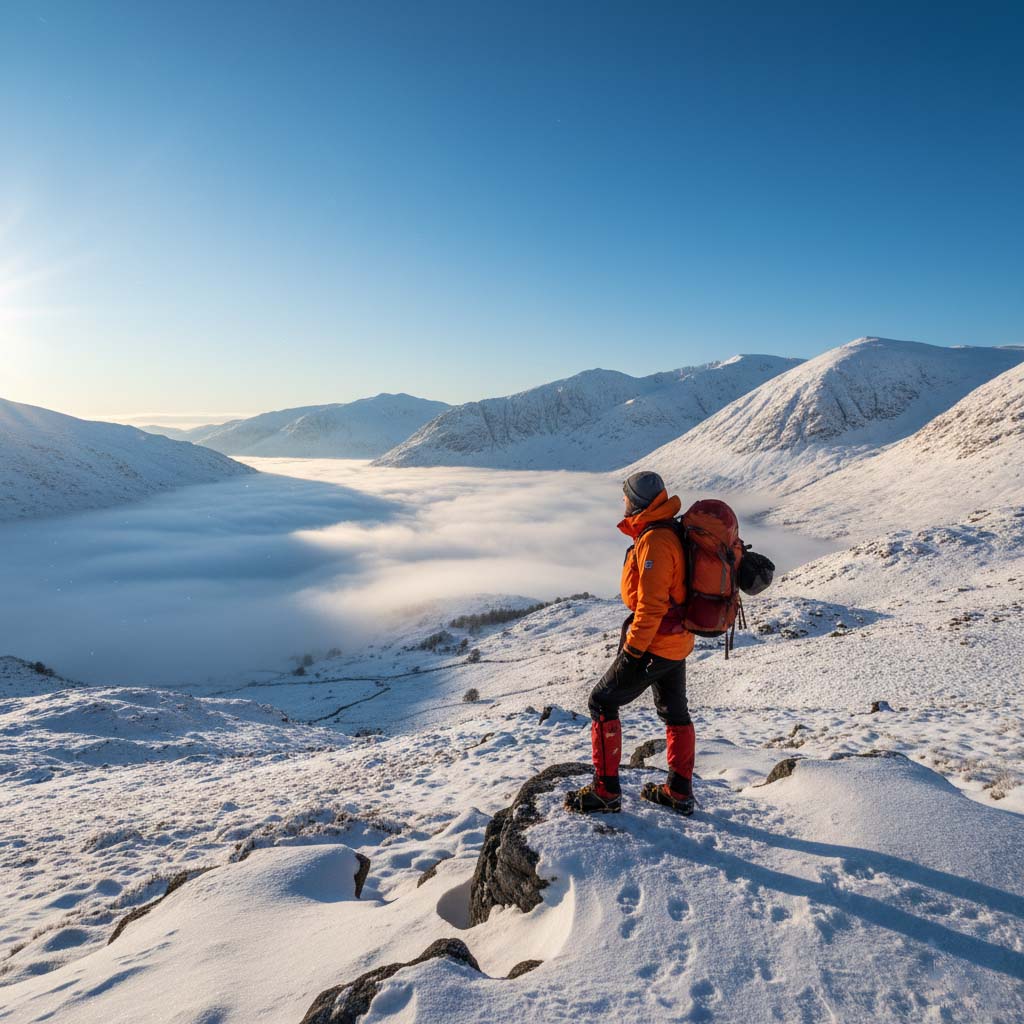Live Mountain Forecast
This live forecast from the Met Office is essential for planning any fell walking. Conditions on the mountains can change rapidly.
Lake District Weather Spring (March – May)

Spring in the Lake District is beautiful as the landscape awakens, but the weather can be varied and unpredictable.
Temperature
- March: Still quite cold, average highs 7–9 °C (45–48 °F); nights often at or below freezing.
- April: Milder, average highs 10–13 °C (50–55 °F).
- May: Mildest spring month, highs 14–17 °C (57–63 °F), sometimes warmer.
Sunshine
- Increasing daylight and sunshine compared to winter.
- Clear skies can lead to frosty nights, especially in March and early April.
- May typically has the most sunshine hours of the season.
Rainfall
- Still one of the UK’s wetter regions; showers are frequent in March and April.
- May is a touch drier but significant rain remains possible.
Wind
- Can be strong on higher fells, adding considerable wind‑chill.
- Gales are less frequent than winter but still possible.
Snow
- March: Common on higher fells; occasional lower‑level falls.
- April: Lingering patches on peaks; late falls not unheard of.
- May: Rare; mainly residual patches on highest north‑facing slopes.
Overall Character
Four seasons in one day is possible: sunshine, showers, hail, or sleet within hours. Daffodils bloom, lambs appear, and paths can be muddy. March and early April are quieter; Easter and May are busier.
What to Pack
- Layered clothing; waterproof jacket and trousers.
- Warm fleece or mid‑layer; moisture‑wicking base layers.
- Hat and gloves (especially March/April and on higher fells).
- Sturdy waterproof walking boots and plenty of socks.
- Sunscreen and sunglasses.
Lake District Weather Summer (June – August)

Summer is the most popular season thanks to warmer temperatures and long daylight hours — but showers remain likely.
Temperature
- June: Mild and pleasant; highs 15–18 °C (59–64 °F). Nights 8–11 °C (46–52 °F).
- July: Often warmest; highs 17–20 °C (63–68 °F) with short spells in the low/mid‑20s °C.
- August: Similar to July, perhaps a little cooler toward month‑end; highs 17–19 °C (63–66 °F).
Sunshine
- Longest days with bright evenings ideal for extended walks.
- Sunny spells can be interspersed with cloud and showers.
Rainfall
- Generally drier than autumn and winter, but rain is still common.
- Sudden downpours or thunderstorms can occur (especially July/August).
- “Summer rain” can be chilly and persistent.
Wind
- Usually lighter at low levels; higher fells can still be breezy.
- Wind + rain on tops can make it feel much cooler.
Overall Character
Best chance of warmth. Lush, green landscapes and lively towns (Windermere, Ambleside, Keswick). Expect crowds on popular trails; accommodation and attractions often need advance booking. Midges may appear on calm, damp evenings.
What to Pack
- Lightweight waterproof jacket and trousers (essential).
- T‑shirts and long sleeves (for sun/cooler days); walking shorts or trousers.
- Fleece or light jumper for evenings and higher fells.
- Sturdy boots or walking shoes.
- Sun hat, sunglasses, sunscreen; insect repellent.
- Swimsuit for lake/tarn dips (be aware of cold‑water shock and water safety).
Lake District Weather Winter (December – February)

Winter brings dramatic scenery and challenging conditions — preparation is essential.
Temperature
- December: Highs 5–7 °C (41–45 °F); frequent frosts overnight.
- January: Coldest month; highs 3–6 °C (37–43 °F); fell tops well below freezing.
- February: Similar to January, with slightly longer days; highs 4–7 °C (39–45 °F).
Sunshine
- Short daylight hours; many overcast days.
- Clear spells produce spectacular light over snow‑topped peaks.
- Valleys can hold mist/fog while higher fells sit above an inversion.
Rainfall
- Typically the wettest season.
- Frequent, at times heavy and persistent rain at lower levels.
- Rain often turns to sleet or snow on higher ground.
Snow
- Common and long‑lasting on the fells; drifts and cornices can form.
- Valley snow is possible in cold spells and can disrupt travel.
- Hidden ice can be hazardous on paths, roads and slopes; avalanche risk can be present.
Wind
- Very strong on fells; gales can make walking hazardous or impossible.
- Wind chill can be severe.
Overall Character
On calm, clear days the snowy landscapes are breathtaking; in storms they are harsh with low visibility, driving rain/snow and biting winds. It’s generally the quietest season (except Christmas/New Year) and some attractions close. Winter fell‑walking demands experience, sound judgement and specialist kit.
What to Pack
- Heavy‑duty waterproof jacket and trousers.
- Warm mid‑layers or insulated jacket; thermal base layers.
- Very warm hat/balaclava; waterproof gloves or mittens; scarf.
- Sturdy, waterproof, insulated boots with good grip; gaiters.
- Headtorch (short days) and a hot flask.
- For fells: ice axe, crampons, map, compass, GPS, emergency shelter — and the skills to use them.
What to Pack — Quick Summary
- Always: Waterproof jacket & trousers, layered clothing, sturdy footwear, map/phone, snacks and water.
- Spring: Add hat/gloves; expect changeable conditions and muddy paths.
- Summer: Add sun protection and insect repellent; still carry waterproofs.
- Winter: Add insulated layers, headtorch, and (for fells) winter kit like axe/crampons.